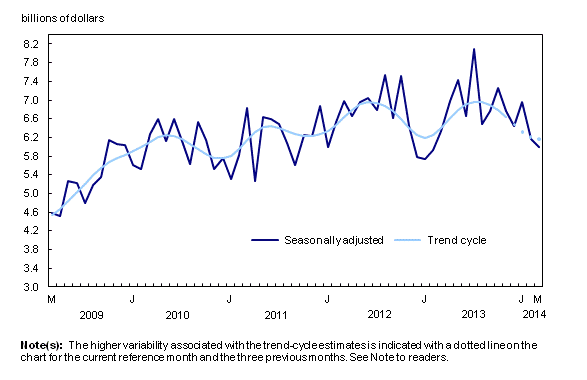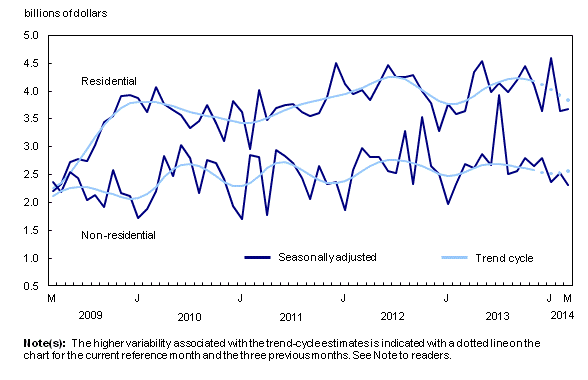Building Permits — March 2014

Contractors took out $6 billion worth of building permits in March, down 3% from February. The March decline followed an 11.3% decrease the previous month. Lower construction intentions in the non-residential sector in six provinces, led by Ontario, more than offset a gain in the residential sector.
Chart 1: Total value of permits
Construction intentions in the non-residential sector fell 8.8% to $2.3 billion in March, the lowest level since January 2013. This follows a 7.4% increase the previous month. Declines were recorded in six provinces, with Ontario accounting for most of the decrease. Gains were registered in four provinces, led by Alberta, followed by Nova Scotia and BC.
In the residential sector, the value of permits rose 1.0% to $3.7 billion, following a 20.8% decrease in February. Higher residential construction intentions were registered in five provinces, led by BC and Saskatchewan. Quebec and New Brunswick posted the largest decreases.
Non-residential sector: institutional and industrial components down
Canadian municipalities issued $467 million worth of institutional building permits in March, down 31.3% from February. The value of institutional building permits was down in five provinces. Ontario accounted for most of the decrease, the result of lower construction intentions for medical facilities. BC and Alberta posted the largest gains in March, as a result of educational institutions.
After posting a 29.7% increase in February, the value of permits in the industrial component fell 7.7% in March to $329 million. Declines in four provinces, led by Quebec and Ontario, offset increases in the other provinces. The decline resulted largely from lower construction intentions for mining facilities and agricultural buildings in Quebec, as well as manufacturing plants in Ontario and Quebec. BC recorded the largest gain, followed by New Brunswick and Nova Scotia.
In the commercial component, the value of permits rose 1.2% to $1.5 billion. Alberta accounted for most of the increase as a result of higher construction intentions for retail complexes and hotels and restaurants. BC and Saskatchewan posted the largest declines, mostly the result of lower construction intentions for office buildings.
Chart 2: Residential and non-residential sectors

Residential sector: higher construction intentions for multi-family dwellings
The value of permits for multi-family dwellings rose 7.9% to $1.6 billion in March, following a 30.7% decrease the previous month. Increases were reported in most provinces, led by Ontario and BC.
Construction intentions for single-family dwellings fell 3.6% to $2.1 billion. This was the fourth decrease in five months and marked the lowest level for the component since February 2011. Declines were registered in seven provinces, with Ontario and New Brunswick posting the largest decreases.
Canadian municipalities approved the construction of 15,833 new dwellings, 12.2% more than in February. The rise was attributable to multi-family dwellings, which increased 21.2% to 10,191 units. In contrast, single-family dwellings fell 1.2% to 5,642 units.
Provinces: significant decline in Ontario
The total value of permits was down in five provinces in March, with Ontario posting the largest decline, followed by Quebec and New Brunswick.
The large decrease in Ontario was mainly the result of lower construction intentions for institutional buildings and, to a lesser extent, single-family dwellings and industrial buildings. In Quebec, the monthly decrease was attributable to industrial buildings and multi-family dwellings, while lower construction intentions for single-family dwellings and commercial buildings were the reason for the decline in New Brunswick.
The largest increase occurred in Alberta, where commercial building intentions were mainly responsible for the growth. BC was a distant second, followed by Nova Scotia. Institutional buildings and multi-family dwellings contributed the most to the advance in BC, while commercial buildings and multi-family dwellings were responsible for the gain in Nova Scotia.
Lower construction intentions in Kingston, Kitchener-Cambridge-Waterloo and London
The total value of permits was down in 16 of the 34 census metropolitan areas.
The largest decrease was in Kingston, followed by Kitchener–Cambridge–Waterloo and London. In Kingston, the decrease was largely attributable to drops in institutional buildings. Lower intentions for multi-family dwellings explained the decline in Kitchener–Cambridge–Waterloo, while in London, non-residential building and single-family dwelling construction intentions were behind the decrease.
Edmonton posted the largest increase in March, followed by Oshawa and Quebec City. The value of permits issued in Edmonton grew largely as a result of higher construction intentions for multi-family dwellings, institutional buildings and commercial structures. In Oshawa, commercial buildings were responsible for the advance, while in Quebec City, multi-family dwellings and all components of the non-residential sector accounted for the increase.
Source: Statistics Canada










